EEG Oscillations
There are different ways to measure oscillations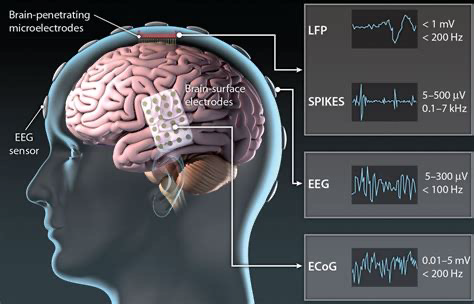
LFP: local field potential
EEG: electroencephalography
EcoG: Electrocorticography
MEG is not commonly used because it is expensive
FASTFOURIER TRANSFORM (FFT): Delta, Theta, Alpha, Beta, Gamma
A Fourier transform (FT) is a mathematical transform that decomposes functions depending on space or time into functions depending on spatial frequency or temporal frequency.
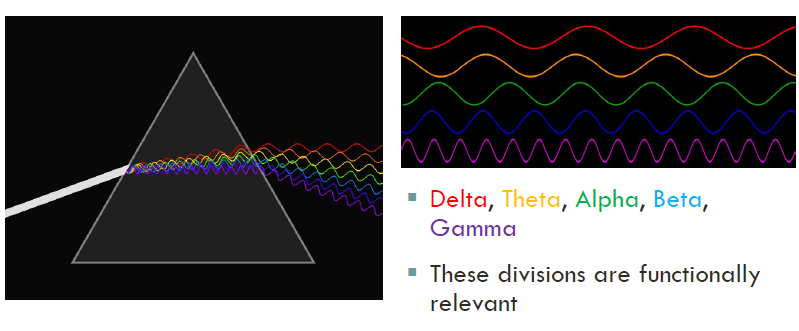
Delta 1 – 3.5 Hz
- Most strongly associated with slow wave sleep in healthy adults, and seen in young infants
- In an awake person, can be related to brain pathology, e.g. stroke, brain trauma, brain infection
- The slow fluctuations need to be distinguished from artifacts with similar temporal activity, e.g. respiration, perspiration
Theta 3.5 – 7.5 Hz
- Whole brain theta linked to arousal, sleep
- In conflict tasks FM theta represents processes involved in the timing of cognitive synchronisation -packaging of information for communication in the cortex, e.g. theta-gamma coupling
- Theta waves (6 Hz) studied in “place cells” by O’Keefe and Nadel in rat hippocampus
Alpha 7.5 – 12.5 Hz
- Strong, clear and characteristic wave observable even in raw data e.g. “Berger’s wave”
- Produced when quietly sitting in relaxed position, enhanced with eyes closed
- Generally, mental activity is associated with reduced alpha power
Beta 12.5 – ~30 Hz (or low/high)
- Two subtypes of beta oscillations:
Regular oscillations around 20 Hz – related to benzodiazepine
administration, sensorimotor activity- Less rhythmic oscillations between 14 and 30 Hz greatest during
mental thought and activity, such as completing a cognitive task
- Less rhythmic oscillations between 14 and 30 Hz greatest during
- Evidence for existence of multiple beta rhythms
Gamma 30 Hz+
Conclusions
- Oscillations are part of how the brain organises perception, cognition and action
- We can measure brain oscillations using various methods: EEG is the most accessible and non-invasive
- Brain oscillations are altered in a number of brain and mental health conditions
- Stimulating oscillations via entrainment may have therapeutic benefits for various disorders, including dementia
- Brain oscillations and their measurement opens up new possibilities for brain machine/computer interfaces, which hold exciting therapeutic possibilities for those affected by neural degeneration or brain injury
Bayesian optimisation machine learning (Machine Learning Applied to Neurosciences)
Optimization
learning objectives
- Distinguishing between Artificial Intelligence and Machine Learning;
- Develop an understanding of how machines learn from data;
- Understanding the concepts of bias and variance and how to balance them;
- Understanding the advantages and shortcomings of using Machine Learning for modelling the brain and behaviour
AI and ML are different concepts: AI encapsulates ML:
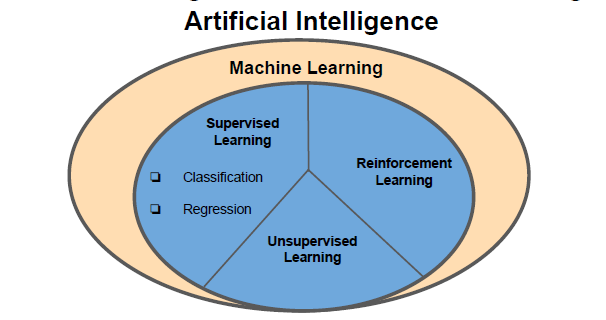
In Machine Learning models learn from experience. In supervised learning
they use their errors to adapt their behaviour;
Supervised learning
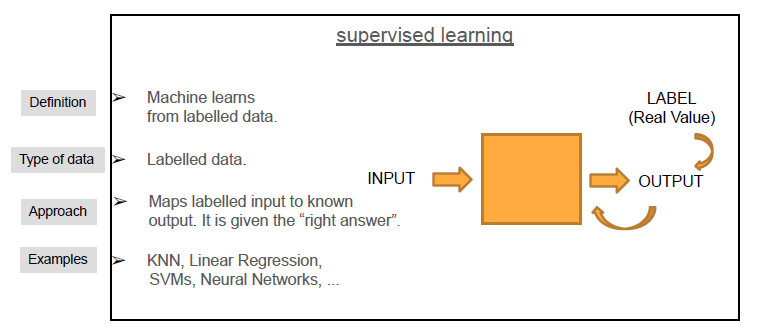
Classification (focuses on predicting a label) & Regression (focuses on predicting a quantity)
Unsupervised learning
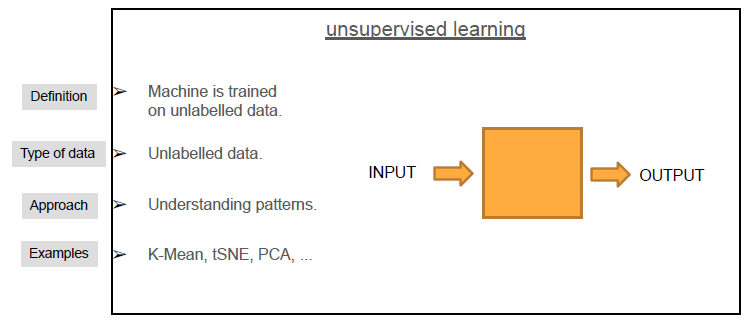
Example of unsupervised learning – K-means clustering
https://www.naftaliharris.com/blog/visualizing-k-means-clustering/
Reinforcement learning
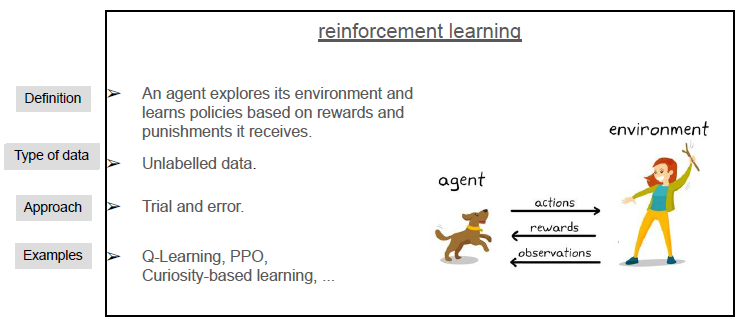
However the fitting can be underfitting or overfitting
| Underfitting | overfitting |
|---|---|
| model has limited flexibility to learn the true signal. high bias. solution :increase number of features. |
model is too complex and is fitting to noise instead of the signal. high variance. solutions: 1. increase number of samples; 2. separate training and test sets; 3. constrain the parameters to reduce complexity (regularization). |
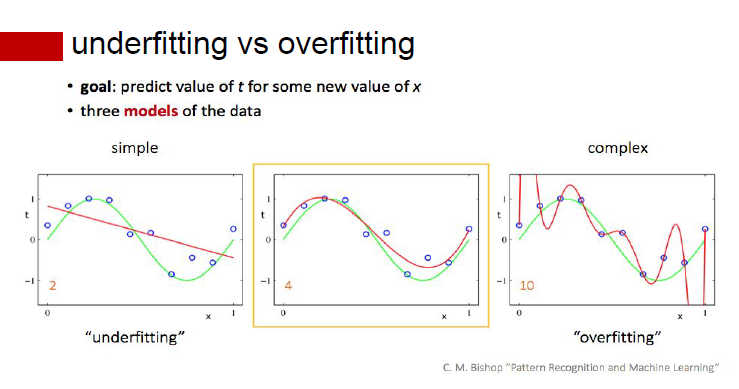
What happens as we train a model:
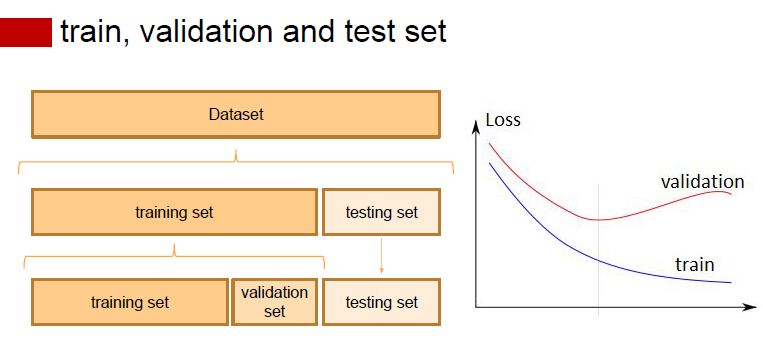
When fitting a model, one should avoid errors of bias and variance by using a
training, a validation and a test set.
There have been some interesting results in modelling the brain with machine
learning but it still has some limitations.
Clinical implementation pros and cons:
Pros:
- high precision
- allows almost immediate diagnosis
- can scale to places with scarcity of resources
Cons:
- lack of explainibility
- problem with generalisation
Bayesian optimization is a method to find the maximum of expensive functions
Conclusion:
- AI and ML are different concepts: AI encapsulates ML;
- In Machine Learning models learn from experience. In supervised learning they use their errors to adapt their behaviour;
- When fitting a model, one should avoid errors of bias and variance by using a training, a validation and a test set;
- There have been some interesting results in modelling the brain with machine learning but it still has some limitations.
Clinical application of fMRI feedback
Objective
- To understand what real-time fMRI (rtfMRI) is and how it differs from conventional fMRI
- To learn how and where rtfMRI can be implemented
- To know some of the applications of rtfMRI
- To understand neurofeedback in the context of rtfMRI
- To know some of the applications of neurofeedback with real-time fMRI
Real time fMRI (rtfMRI)
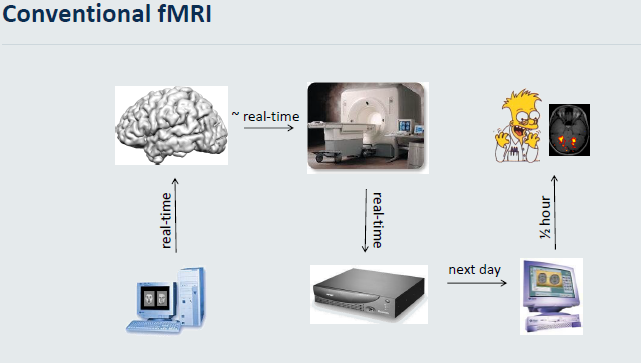
What makes the results real-time
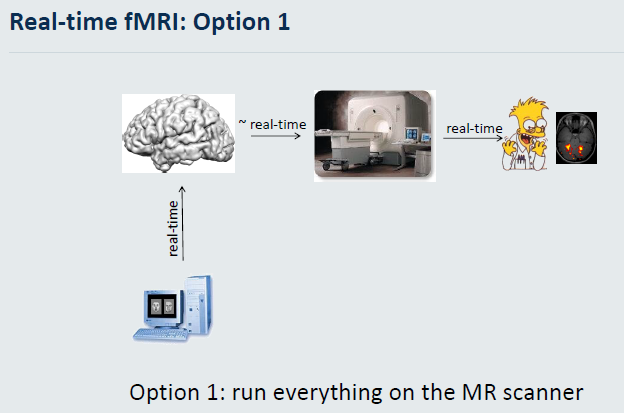
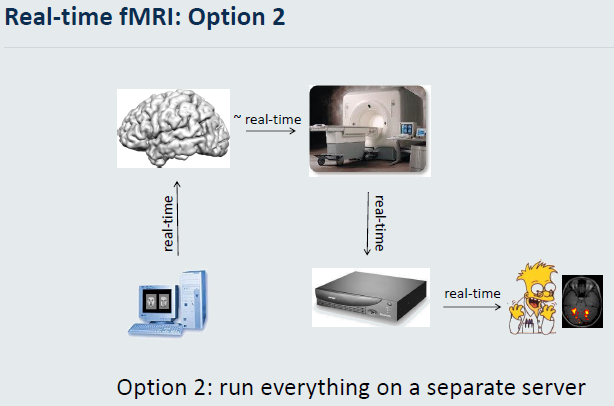
Optimising the pre-processing
Most of the usual pre processing options have been adapted to run in real time.
But most often limited to real time motion correction and some form of temporal smoothing (detrending)
What can make the fMRI steps run faster:
All the fMRI steps can be made to run faster:
- Image acquisition
- Image reconstruction
- Pre-processing
- Statistical analysis
Application s of real-time fMRI:
- Quality control
- Branching protocols
- Presurgical mapping
- Neurofeedback
Real time fMRI for quality control:
- Real-time fMRI makes it possible to detect problems as they happen
- You can stop/restart the scan if needed (e.g., when participant is not doing the task or moving too much)
- Especially important for (rare) patients, children or elderly who may not come back
- Test and tweak experimental protocol during scan
- Change difficulty / stimulation levels
- Test different hardware
- Detect non-desirable cognitive strategies (e.g., verbal strategy during pictorial delayed matched to sample (DMTS) task)
- Cut task short when analysis results are stable
- Can lead to reduced costs, anxiety, habituation, and boredom
Neurofeedback
Biofeedback is employed to control body functions which are not generally directly accessible, or which cannot be evaluated.
Biofeedback is called neurofeedback when it is about the control of brain functions.
Implementation of neurofeedback with rtfMRI:
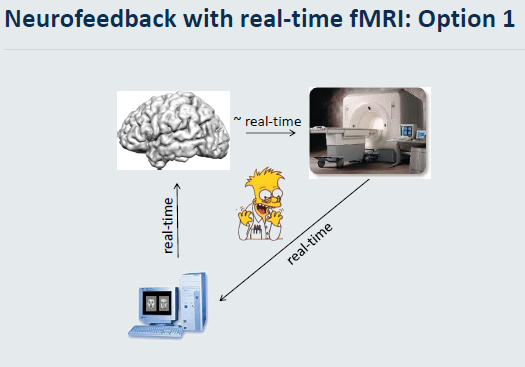
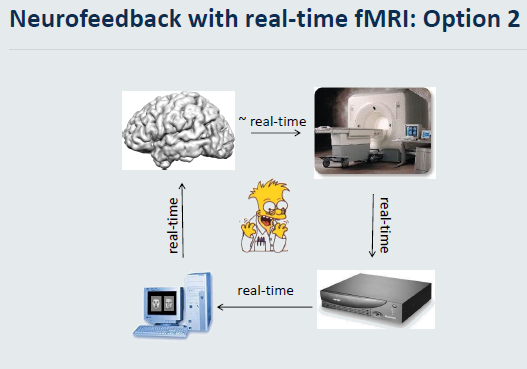
Real time fMRI Neurofeedback may improve chronic Tinnitus: DOI: 0.007/s00330-009-1595-z
Stroke: DOI: 10.1177/1545968311418345
Brain Computer Interface (BCI)
Neuroscience of fear, anxiety and defence
Learning objectives
- Understand the relationship between defensive behaviour and
the situation. - Understand how anti-anxiety drugs can be used to study
defensive behaviour. - Understand how abstract stimuli affect anxiety.
Anxiety
Definition
Jeffrey Gray’s definition: whatever is affected by anti-anxiety drugs. This is not a circular argument because he found these drugs also affect punishment-related behaviour in rodents, increasing approach to locations or stimuli that have been associated with painful electric shock.
Extended and refined by Philip Corr and Neil McNaughton: This has resulted in the key theory of defensive direction, which splits general punishment/threat sensitivity into sensitivity to threats that require approach (anxiety-proneness) and sensitivity to threats that need not be approached
(fear-proneness).
Søren Kierkegaard, The Concept of Anxiety (1844): Anxiety informs us of our choices, our self-awareness and personal responsibility, and brings us from a state of un-self-conscious immediacy to self-conscious reflection.
How can we test abstract anxiety objectively?
The moral dilemma task
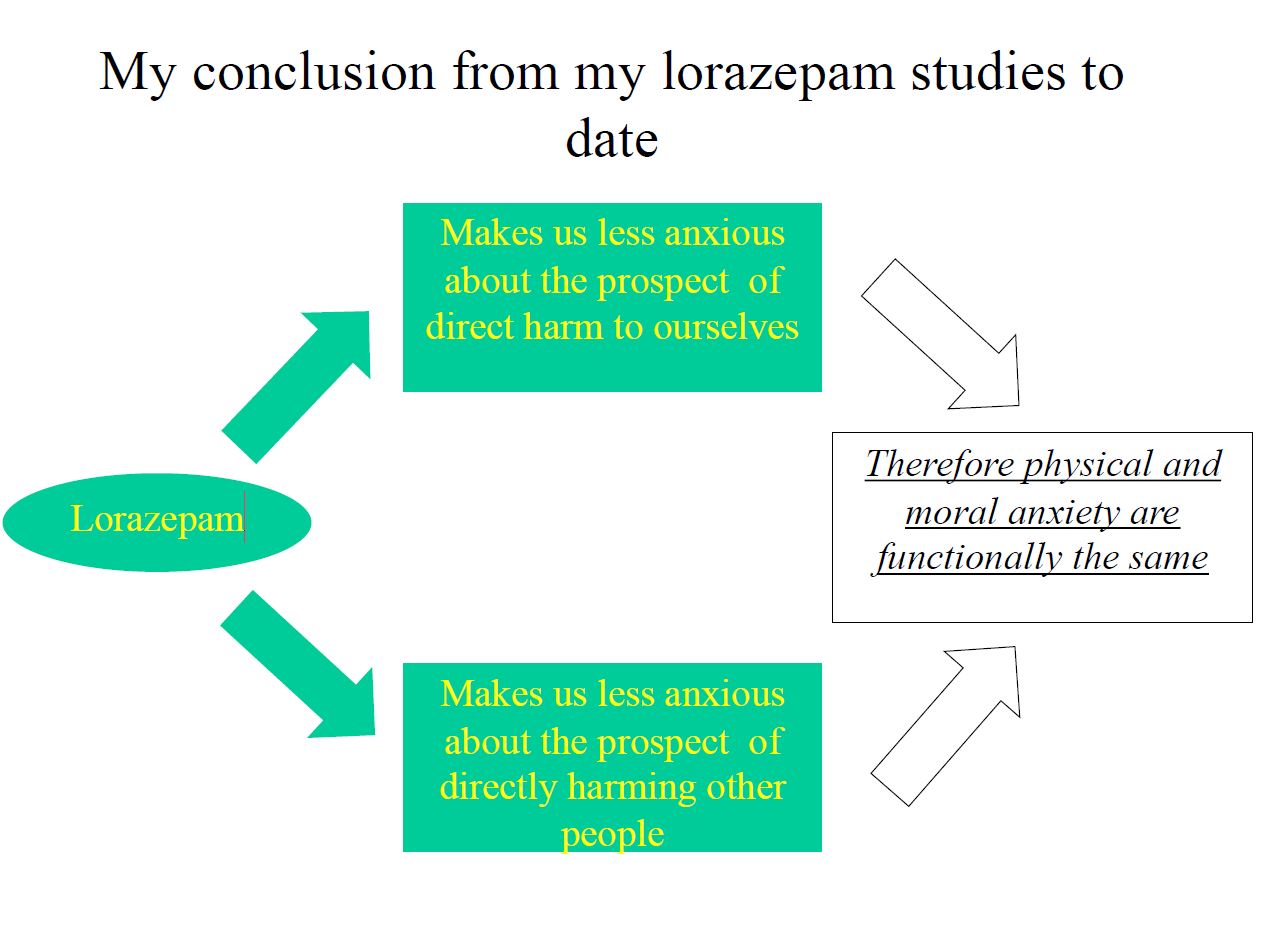
Summary
This research (Adam Perkins) shows that the same anti-anxiety drug affects responses to threat and moral judgment, suggesting that the same brain systems underlie both processes and that previously abstract philosophical concepts may be explained in functional, evolutionary terms.
Vocabularies
Entrainment: the process of making something have the same pattern or rhythm as something else
BCI: brain computer interface
Lorazepam: a drug of the benzodiazepine group, used especially to treat anxiety.


